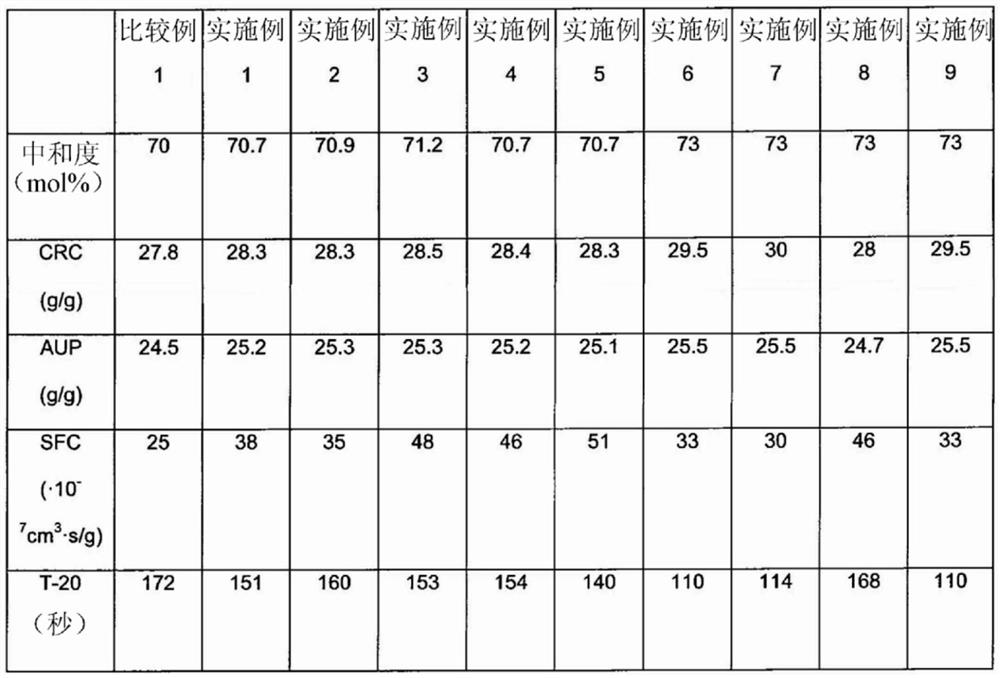Method for preparing super absorbent polymer, and super absorbent polymer
A superabsorbent and polymer technology, applied in the field of superabsorbent polymers, can solve the problems of reduced absorption rate and absorption rate, increased internal crosslink density, etc.
- Summary
- Abstract
- Description
- Claims
- Application Information
AI Technical Summary
Problems solved by technology
Method used
Image
Examples
Embodiment 1
[0124] [Example 1]: Preparation of superabsorbent polymer
[0125] A base resin powder was prepared in the same manner as in Comparative Example 1, and a surface treatment process using ethylene carbonate was also performed in the same manner as in Comparative Example 1.
[0126] After the surface treatment, the temperature of the superabsorbent polymer was cooled to 90° C., and based on 100 g of superabsorbent polymer was mixed with 2.0 g of 5% by weight sodium hydroxide solution for an additional neutralization process.
[0127] Thereafter, the additionally neutralized superabsorbent polymer was dried in an oven at 40° C. for 30 minutes, and a surface-treated superabsorbent polymer having a particle diameter of 150 μm to 850 μm was obtained using a sieve. Fine powders with a particle size of less than 150 μm are contained in the superabsorbent polymer at less than 2% by weight.
Embodiment 2
[0128] [Example 2]: Preparation of superabsorbent polymer
[0129] A base resin powder was prepared in the same manner as in Comparative Example 1, and a surface treatment process using ethylene carbonate was also performed in the same manner as in Comparative Example 1.
[0130] After the surface treatment, the temperature of the superabsorbent polymer was cooled to 90° C., and based on 100 g of superabsorbent polymer was mixed with 10.0 g of 5% by weight sodium hydroxide solution for an additional neutralization process.
[0131] Thereafter, the additionally neutralized superabsorbent polymer was dried in an oven at 40° C. for 30 minutes, and a surface-treated superabsorbent polymer having a particle diameter of 150 μm to 850 μm was obtained using a sieve. Fine powders with a particle size of less than 150 μm are contained in the superabsorbent polymer at less than 2% by weight.
Embodiment 3
[0132] [Example 3]: Preparation of superabsorbent polymer
[0133] A base resin powder was prepared in the same manner as in Comparative Example 1, and a surface treatment process using ethylene carbonate was also performed in the same manner as in Comparative Example 1.
[0134] After the surface treatment, the temperature of the superabsorbent polymer was cooled to 90° C. and based on 100 g of superabsorbent polymer mixed with 20.0 g of 5% by weight sodium hydroxide solution for an additional neutralization process.
[0135] Thereafter, the additionally neutralized superabsorbent polymer was dried in an oven at 40° C. for 30 minutes, and a surface-treated superabsorbent polymer having a particle diameter of 150 μm to 850 μm was obtained using a sieve. Fine powders with a particle size of less than 150 μm are contained in the superabsorbent polymer at less than 2% by weight.
PUM
| Property | Measurement | Unit |
|---|---|---|
| Particle size | aaaaa | aaaaa |
| Particle size | aaaaa | aaaaa |
Abstract
Description
Claims
Application Information
 Login to View More
Login to View More - R&D
- Intellectual Property
- Life Sciences
- Materials
- Tech Scout
- Unparalleled Data Quality
- Higher Quality Content
- 60% Fewer Hallucinations
Browse by: Latest US Patents, China's latest patents, Technical Efficacy Thesaurus, Application Domain, Technology Topic, Popular Technical Reports.
© 2025 PatSnap. All rights reserved.Legal|Privacy policy|Modern Slavery Act Transparency Statement|Sitemap|About US| Contact US: help@patsnap.com

